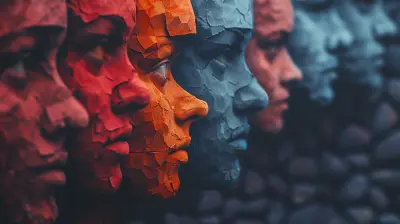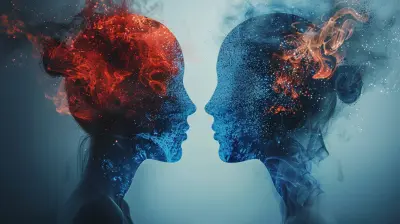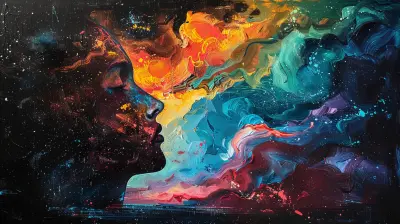The Neuroscience of Cravings: Why We Struggle to Break Addictive Patterns
24 June 2025
Cravings. We all have them. Whether it's the irresistible pull of chocolate, the need for that extra glass of wine, or the compulsive urge to scroll through social media, our brains seem to work against us when we try to say no. But why? What makes these cravings so powerful, and why do we struggle to break free from addictive patterns?
The answer lies deep within our brains, in the intricate wiring of our neural circuits. Let’s dive into the fascinating world of neuroscience to understand why cravings happen and what we can do about them.

Understanding Cravings: What’s Really Happening in Your Brain?
Cravings aren’t just random urges—they are deeply rooted in our brain's reward system. When we engage in pleasurable activities, whether it's eating, shopping, or gambling, our brain releases dopamine, a neurotransmitter often referred to as the "feel-good chemical."Dopamine plays a crucial role in reinforcing behaviors. The more often we indulge in a particular activity, the stronger the connection becomes in our brain. This is why certain habits, especially those linked to immediate rewards, can be so hard to break.
The Role of Dopamine in Addiction
Think of dopamine like a motivational speaker cheering you on every time you do something enjoyable. It’s the reason you feel excited when you see your favorite dessert or anticipate the buzz after a drink. But here's the catch: the more you indulge in these behaviors, the more your brain demands.Over time, your brain adapts by reducing its natural dopamine production, making you crave the substance or activity even more just to feel "normal." This cycle is what fuels addiction.

The Brain’s Habit Loop: Why Breaking Patterns is So Hard
Habits, including addictive behaviors, follow a three-step loop:1. Cue: Something triggers your craving (stress, boredom, seeing a certain place or person).
2. Routine: You engage in the behavior (smoking, eating junk food, checking your phone).
3. Reward: Your brain releases dopamine, reinforcing the habit.
This loop becomes automatic, making it incredibly difficult to break. The brain craves efficiency, and once it establishes a habit, it follows that path with minimal effort—like a well-worn hiking trail in a forest.
Why Willpower Alone Isn’t Enough
Many people believe overcoming addiction or cravings is just about self-control. "Just stop doing it," they say. But if only it were that simple! The problem is that willpower is like a muscle—it gets exhausted over time.When you're stressed, tired, or emotional, your brain defaults to autopilot, making it even harder to resist cravings. This is why people relapse or struggle to quit bad habits even when they genuinely want to.

How Cravings Hijack Your Brain
Cravings can feel overwhelming because they hijack key areas of the brain:- The Prefrontal Cortex: This is your brain's decision-making center. In addiction, its ability to regulate impulses weakens, making self-control difficult.
- The Amygdala: This region processes emotions like fear and anxiety. It can amplify cravings during stressful situations.
- The Hippocampus: This part stores memories, including those linked to pleasure. It reminds you how good that last drink, cigarette, or dessert felt, triggering cravings.
When these areas work together, they create an intense desire that’s hard to ignore.

Why Some People Are More Prone to Cravings
Ever wonder why some people can casually enjoy a piece of chocolate while others feel the need to devour the whole bar? Genetics, environment, and personality all play a role.- Genetics: Some individuals have a genetic predisposition to seeking pleasure, making them more vulnerable to addiction.
- Childhood Experiences: Trauma, neglect, or exposure to substance abuse can shape brain development, increasing the likelihood of addiction later in life.
- Personality Traits: Impulsivity and sensation-seeking behavior can also make someone more prone to cravings.
Breaking the Cycle: How to Overcome Cravings
Now that we understand why cravings are so powerful, how can we fight back? While there’s no magic cure, science offers strategies to regain control.1. Rewire Your Brain with New Habits
Since habits form neural pathways, the best way to break an unhealthy craving is to replace it with a healthier alternative. Instead of quitting cold turkey, swap the habit with a better one.For example:
- Instead of reaching for a cigarette, try deep breathing exercises.
- Replace junk food with a healthier snack like nuts or fruit.
- If stress drives your cravings, engage in exercise or meditation instead.
2. Reduce Triggers
Identify what sparks your cravings and find ways to eliminate or manage them. If you crave sweets after meals, switch to herbal tea. If social media distractions affect your productivity, use app blockers. The fewer triggers, the lower the temptation.3. Practice Mindfulness
Mindfulness helps you become more aware of your cravings without acting on them. When a craving strikes, pause and observe your thoughts. Ask yourself:- Am I really hungry, or am I just bored?
- Will I feel better after I indulge in this habit?
- Can I wait 10 minutes and see if the craving passes?
More often than not, cravings disappear when we acknowledge them without giving in.
4. Get Enough Sleep
Lack of sleep decreases the prefrontal cortex’s ability to regulate impulses, making cravings harder to resist. Aim for 7-9 hours of quality sleep to keep your brain in top shape.5. Stay Busy and Distract Yourself
Boredom is a common trigger for cravings. Keep yourself engaged in activities that require focus—reading, puzzles, hobbies, or even going for a walk. A busy mind has less room for temptation.6. Seek Support
Overcoming addiction or strong cravings isn’t easy, and there’s no shame in seeking help. Talking to a therapist, joining a support group, or confiding in a friend can provide the accountability and encouragement you need.7. Gradual Reduction Works Better Than “All or Nothing”
Cutting off a habit entirely can sometimes backfire, leading to intense withdrawal cravings. A more effective approach is to gradually reduce the frequency or amount. If you drink multiple sodas a day, start by cutting back to one, then switch to flavored water.
Conclusion: Winning the Battle Against Cravings
Breaking free from cravings and addictive patterns is a challenge, but understanding the neuroscience behind them gives you an advantage. The key is to recognize that cravings are simply your brain’s way of seeking pleasure and comfort.By rewiring your habits, reducing triggers, and practicing mindfulness, you can regain control and break free from the cycle. It won’t happen overnight, but with patience and persistence, you can train your brain to crave healthier, more fulfilling alternatives.
So, the next time a craving strikes, pause for a moment. Instead of giving in automatically, challenge it. Your brain is powerful—use it to your advantage.
all images in this post were generated using AI tools
Category:
AddictionAuthor:

Gloria McVicar
Discussion
rate this article
2 comments
Easton McCord
Understanding the neuroscience of cravings empowers us to break free from addictive patterns. Change is possible—embrace the journey toward a healthier you!
November 28, 2025 at 4:48 AM
Ella Carr
This article brilliantly explores the interplay between neuroscience and cravings, shedding light on the complex mechanisms behind addictive behaviors. A must-read for those seeking understanding!
July 8, 2025 at 3:59 PM

Gloria McVicar
Thank you for your kind words! I'm glad you found the article insightful and engaging.


